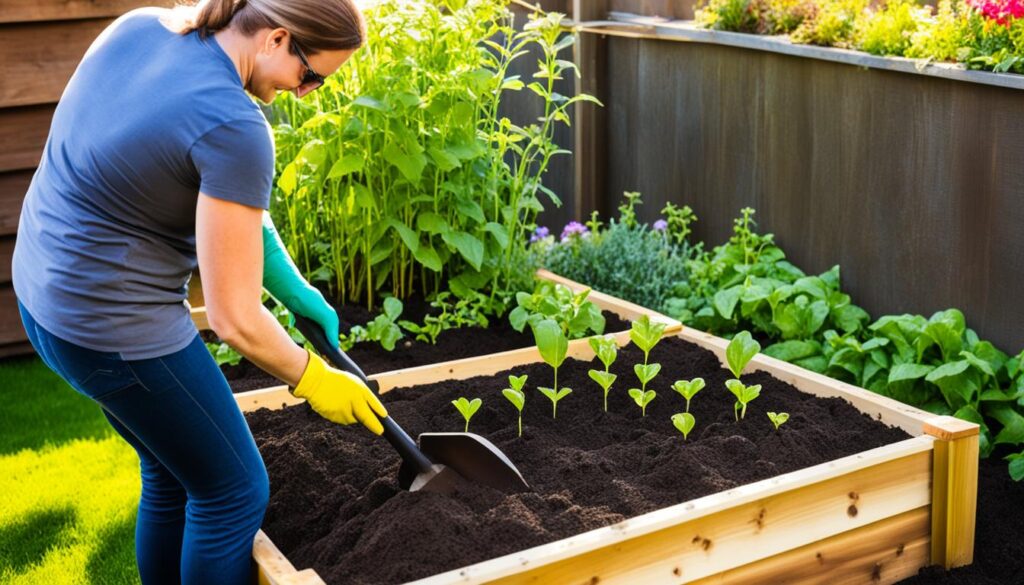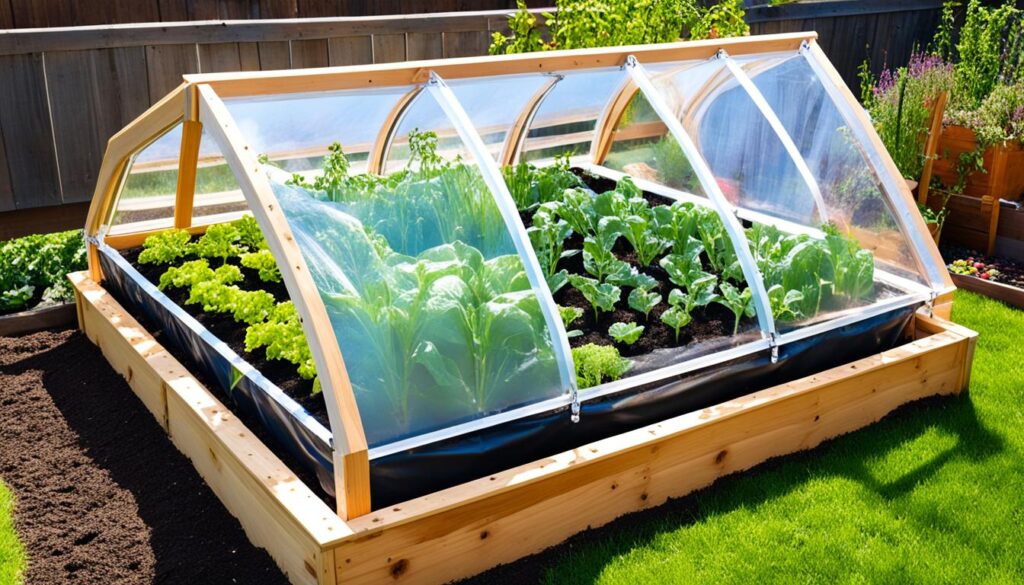Greetings, fellow DIY enthusiasts! Today, I want to share with you a brilliant and budget-friendly project: building a shed out of pallets. With just a few basic tools and some creativity, you can create a practical and sustainable storage solution for your garden. So, let’s dive in and discover how to make a shed using pallets!
Shed building with pallets offers a fantastic opportunity to repurpose materials and reduce waste. By using pallets, you can create a unique and personalized shed that fits your garden space perfectly. Plus, it’s a fun and rewarding project that allows you to unleash your DIY skills!
Are you ready to get started on your very own DIY pallet shed? Let me guide you through each step, from gathering the necessary tools and materials to adding the finishing touches. By the end of this guide, you’ll have a functional and eye-catching shed that will impress your friends and neighbors.
Key Takeaways:
- Building a shed out of pallets is a sustainable and cost-effective solution for your storage needs.
- With the right tools and materials, you can create a functional and attractive shed.
- Start by gathering the tools and materials, including cordless drill/driver, saw, pallets, screws, and more.
- Create a sturdy base for your shed by leveling the area and attaching pallets to ground contact rated lumber.
- Continue adding pallets to form the walls, ensuring they are securely attached to each other and the ground.
Building your own shed out of pallets is a rewarding experience that combines creativity and practicality. So, roll up your sleeves, grab your tools, and let’s embark on this exciting DIY journey together!
Step 1: Tools & Materials
To build a shed made from pallets, you will need the following tools and materials:
Tools:
- Cordless drill/driver
- Phillips heads for screws
- Drill bit for drilling all-thread bolt holes
- Circular saw
- Oscillating tool
- Level
- Step ladder
- Pliers
- Tape measure
Materials:
- Dozens of pallets
- All-thread bolts, nuts and washers
- Screws
- Assorted door hardware
- Roofing tin
- Chipboard
To construct your pallet shed, these tools and materials are essential for pallet shed construction and pallet shed design. The cordless drill/driver will be instrumental in securing the pallets together, while the Phillips heads for screws will provide a strong connection. The drill bit for drilling all-thread bolt holes ensures stability and durability in the structure. The circular saw and oscillating tool will allow you to make precise cuts and adjustments as needed. The level will help maintain a straight and level foundation, and the step ladder will enable you to reach higher areas during assembly. Pliers are useful for gripping and maneuvering materials, and a tape measure will ensure accurate measurements for precise construction. Additionally, the dozens of pallets will be the primary building material for your shed, offering recyclability and affordability. All-thread bolts, nuts, and washers impart strength and stability to the structure, while screws secure the pallets to one another. Assorted door hardware, roofing tin, and chipboard will complete the shed’s functionality and aesthetic appeal.
Step 2: Build Your Base
Now that you have prepared your tools and materials, it’s time to start building the foundation of your pallet shed. Building a sturdy base is crucial to ensure the stability and longevity of your shed.
Here’s a step-by-step guide on how to build your base:
- Start by leveling out a 10′ square area for your shed. Clear any debris or vegetation from the site to create a clean working space.
- Elevate the area by placing cement blocks at strategic points. This will prevent moisture from seeping into the base and causing damage.
- Attach the first two 4’x6′ pallets to ground contact rated 10′ 2×4’s using screws. Make sure to align the pallets properly and secure them tightly to the lumber.
- Use a long 5/8″ drill bit to drill holes through the pallets. This will allow you to bolt them together for added stability.
- Insert all-thread bolts through the drilled holes and secure them with nuts and washers. Tighten the bolts using pliers to ensure a secure connection.
By following these steps, you will establish a solid base for your pallet shed. This foundation will provide the necessary support for the rest of the construction process.
Step 3: Working Your Way Around
Now that we have the base in place, it’s time to start building up the walls of our pallet shed. In this step, we will add more pallets to the back and sides of the shed to create the structure and shape we desire. Let’s get started!
- Prepare the pallets: Before attaching the pallets, make sure they are clean and in good condition. Remove any nails or loose boards to ensure a secure fit.
- Position the pallets: Place the pallets vertically against the back and side of the shed, aligning them with the base. Make sure they are flush against each other and the ground contact lumber.
- Secure with screws and bolts: Use screws to attach the pallets to the ground contact lumber, ensuring a strong and stable connection. Additionally, use all-thread bolts, nuts, and washers to securely fasten the pallets to each other, reinforcing the overall structure.
- Check for stability: After attaching each pallet, step back and assess the stability of the shed. Make any necessary adjustments to ensure everything is secure and level.
By following these steps, you will gradually build up the walls of your pallet shed, transforming it from a simple base to a sturdy structure that will protect your belongings. Take your time and pay attention to detail, as it is crucial for the overall stability and durability of the shed.
To give you a visual representation of this step, take a look at the example below:
| Image 1 | Image 2 | Image 3 |
These images showcase the process of adding pallets to the back and sides of the shed, ensuring a sturdy and secure structure. Use them as a reference to guide you through this step of your pallet shed project.
Step 4: Keep Working Around
As I continue building my pallet shed, it’s time to focus on completing the side walls. This step is crucial for reinforcing the structure and ensuring the stability of the shed. To accomplish this, I’ll be adding more pallets and securing them in place.
To attach the pallets to the ground contact lumber, I will be using screws. These screws will securely fasten the pallets to the support beams, preventing any unnecessary movement. Additionally, I’ll be using all-thread bolts to connect the pallets to each other side to side. This will create a strong and cohesive wall for the shed.
By incorporating these techniques, I can confidently say that the shed will be able to withstand various weather conditions and provide a durable storage solution. It’s important to ensure that every pallet is securely fastened to maintain the integrity of the structure.
Let’s take a look at the progress I’ve made so far:
| Step | Description |
|---|---|
| Step 1 | Building the base using cement blocks and attaching the initial pallets |
| Step 2 | Adding more pallets to form the back and sides of the shed |
| Step 3 | Continuing to work around the shed, securely attaching the pallets |
| Step 4 | Completing the side walls by adding more pallets and reinforcing them |
As you can see, the shed is gradually taking shape. The addition of each pallet brings it closer to completion and ensures its structural integrity. I’m excited to see the final result as I proceed with the next steps of the project.

Stay tuned for the next step, where I’ll be taking the shed construction to new heights by working on the sides. With each step, we’re getting closer to having a functional and aesthetically pleasing pallet shed.
Step 5: Working Up the Sides
To add height and stability to your DIY pallet shed, it’s time to work up the sides. This step involves adding smaller, regular-sized pallets to complete the side walls of the shed. By following these instructions, you’ll ensure that your shed design is both functional and visually appealing.
Here’s how to proceed:
- Start by selecting pallets that are similar in size to maintain consistency in your shed’s appearance.
- Using screws, attach these smaller pallets to the ground contact lumber, securing them firmly in place. This will provide stability and ensure that the shed remains durable.
- Next, connect the pallets to each other side to side using all-thread bolts. This will further reinforce the structure and prevent any wobbling or sagging.
By following these steps, you will successfully work up the sides of your shed, creating a solid foundation for the remaining construction.
Additional Tips:
Consider arranging the smaller, regular-sized pallets strategically to create a visually interesting pattern on the side walls of your shed.
Now that you’ve completed Step 5, let’s move on to the next section to continue building your DIY pallet shed.
Step 6: Bring It Around the Front
Now that we have built the walls of our pallet shed, it’s time to focus on the front entrance. To frame the doorway and add structural integrity, I recommend using long, skinny pallets. These pallets can be secured vertically on each side of the entrance, creating a sturdy and visually appealing entrance.
Additionally, to ensure stability and support for a temporary roof, it’s essential to add support beams to both the front and back of the shed. I suggest using 2×4 lumber for these beams, as it offers strength and durability. By placing the support beams strategically, you can create a solid framework for the roof.
Overall, this step plays a crucial role in the overall stability and functionality of your pallet shed. By framing the doorway and adding support beams, you’re not only enhancing the structural integrity but also creating a welcoming entrance and preparing the shed for the final touches.

With these additions, your pallet shed is taking shape and nearing completion. In the next step, we’ll focus on adding the doors and roof, turning your project into a fully functional and practical storage space.
Step 7: Adding Doors & Roof
Now that the structure of your pallet shed is complete, it’s time to add the finishing touches. In this step, we’ll focus on building doors and replacing the temporary plastic roof with a more durable option.
Building the Doors
To create the doors for your shed, you’ll need chipboard and pallet tops. These materials can be easily found and repurposed for this project. Begin by measuring the doorway frame and cutting the chipboard to the appropriate size.
Using screws, attach the pallet tops to the chipboard, creating a rustic and unique design. Make sure to make the doors wide enough to accommodate larger items that you plan to store in your shed.
Replacing the Roof
The temporary plastic roof served its purpose during the construction phase, but now it’s time for a more permanent solution. Replace the plastic roof with roofing tin, which offers better protection against the elements.
Attach the roofing tin to the support beams using self-tapping screws, ensuring a secure and watertight installation. The use of roofing tin provides durability and longevity, giving your shed a polished and professional appearance.
| Tools & Materials | Estimated Time |
|---|---|
| Circular saw | 1 hour |
| Drill/driver | |
| Chipboard | |
| Pallet tops | |
| Roofing tin | |
| Self-tapping screws |
By completing this final step, your pallet shed will be fully functional and ready to serve its intended purpose. The addition of the doors and the replacement of the temporary plastic roof will enhance the overall look and usability of your shed.
Now that your shed is complete, you can start organizing your tools, gardening supplies, or any other items you plan to store inside. Enjoy the satisfaction of having built a practical and eco-friendly shed out of pallets!
Conclusion
Building a shed out of pallets is a cost-effective and sustainable DIY project that can provide functional storage space in your garden. With a little creativity, you can transform discarded pallets into a practical and aesthetically pleasing shed.
By following the step-by-step process outlined in this article and using the right tools, such as a cordless drill/driver and circular saw, as well as materials like all-thread bolts and roofing tin, you can successfully construct your own pallet shed.
Take your time and measure carefully to ensure a sturdy and well-built structure. Whether you need additional storage for your gardening tools or want a cozy space for your hobbies, a DIY pallet shed offers versatility and charm.
So why not embark on this exciting project? Get creative with your pallet shed design, make a plan using pallet shed plans, and enjoy the satisfaction of building your own shed with pallets.








